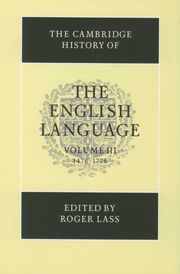3 - Phonology and Morphology
Published online by Cambridge University Press: 28 March 2008
Summary
Introduction
Overview and prospect
The period 1476–1776 covers the end of Middle English, what is generally known as Early Modern English, and the early stages of indisputably ‘modern’, if somewhat old-fashioned, English. At the beginning, the language looks more Middle than Modern, and sounds partly both; at the end it looks and sounds quite, if not fully, modern. I illustrate with two short texts and some comment:
A. Letter of Sir Thomas Wyatt to his son, 1532
I doubt not but long ere this tyme my lettres are come to you. I remember I wrate you in them that if you read them oftin it should be as tho I had written oftin to you: for al that I can not so content me but stil to cal apon you with my lettres. I wold not for al that that if any thing be wel warnid in the other, that you should leaue to remember it becaus of this new, for it is not like with aduertisements as it is with apparel that with long wering a man castith away when he hath new. Honest teching neuir were onles they were out of his remembrans that shold kepe and folow them to the shame and hurt of him self.
(Muir 1960: 248ff)B. Letter of Samuel Johnson to James Boswell, 1774
I am ashamed to think that since I received your letter I have passed so many days without answering it. I think there is no great difficulty in resolving your doubts. The reasons for which you are inclined to visit London, are, I think, not of sufficient strength to answer the objections. I need not tell you what regard you owe to Mrs. Boswell’s entreaties; or how much you ought to study the happiness of her who studies yours with so much diligence, and of whose kindness you enjoy such good effects. Life cannot subsist in society but by reciprocal concessions. She permitted you to ramble last year, you must permit her now to keep you at home.
(Boswell’s Life, Saturday 5 March 1774)- Type
- Chapter
- Information
- The Cambridge History of the English Language , pp. 56 - 186Publisher: Cambridge University PressPrint publication year: 2000
References
- 25
- Cited by

